Assessment of Post-Earthquake Damage: St. Salvatore Church in Acquapagana, Central Italy
Abstract
:1. Introduction
2. The case study of San Salvatore church in Acquapagana
2.1. Territorial Overview
2.2. Historical Description and Material Analysis of the Building
- Good quality of the mortar.
- Presence of bond stones, or stones passing through the entire thickness of the wall.
- Shape of the elements.
- Dimension of the elements.
- Presence of staggering in the vertical joints.
- Presence of horizontal rows.
- Good quality of resistant elements.
2.3. The Identification of Existing Macro-Elements
- Overturning of the façade (mechanism 1)
- Mechanisms of the upper part of the façade (mechanism 2)
- In-plane mechanisms of the façade (mechanism 3)
- Transversal response of the nave (mechanism 5)
- Longitudinal response of the lateral wall, in-plane (mechanism 6)
- Triumphal arches (mechanism 13)
- Overturning of the apse (mechanism 16)
- Shear mechanism of the aps (mechanism 17)
- Vaults of the aps (mechanism 18)
- Mechanism of the element of the roof-lateral walls of the nave (mechanism 19)
- Interaction with annexed buildings (mechanism 25)
- Bell tower (mechanism 27)
- Upper portion of the bell tower (mechanism 28)
2.4. Two Earthquake Episodes in Comparison: the 1997 Umbria-Marche Earthquake and the 2016 Central Italy Earthquake
2.4.1. The 1997 Umbria-Marche Earthquake
2.4.2. The 2016 Central Italy Earthquake
3. Discussion
- In the bell tower, an additional steel structure, tying together the four walls of the bell tower, could guarantee ductility and reduce torsional movement of the upper portion.
- The existing independent steel structure, used to carry the bells, has shown a satisfactory response to seismic actions and probably has reduced the damage to the masonry structure.
4. Conclusions
Acknowledgments
Author Contributions
Conflicts of Interest
References
- Form A-DC PCM-DPC MIBAC. 2006. Available online: http://www.beniculturali.it/mibac/multimedia/MiBAC/documents/1338454237471_allegato4.pdf (accessed on 1 September 2017).
- Doglioni, F.; Moretti, A.; Petrini, V. Le Chiese e il Terremoto; LINT Press: Trieste, Italy, 1994; ISBN 8886179367. [Google Scholar]
- Lagomarsino, S. Seismic damage survey of the churches in Umbria. In Proceedings of the Workshop on Seismic Performance of Monuments, Lisbon, Portugal, 12–14 November 1998. [Google Scholar]
- Doglioni, F.; Mazzotti, P. Codice di Pratica per la Progettazione Degli Interventi di Miglioramento Sismico nel Restauro del Patrimonio Architettonico, 2nd ed.; Regione Marche: Ancona, Italy, 2007; ISBN 978-88-902669-0-4. [Google Scholar]
- Giovanetti, F. Manuale di Recupero. Città di Roma; Edizioni DEI; Tipografia del Genio Civile: Roma, Italy, 1997; ISBN 88-7722-552-1. [Google Scholar]
- Giovanetti, F. Manuale del Recupero del Comune di Città di Castello; Edizioni DEI; Tipografia del Genio Civile: Roma, Italy, 1997; 239p, ISBN 9788849652260. [Google Scholar]
- Giuffrè, A.; Carocci, C. Codice di Pratica per la Conservazione dei Sassi di Matera; Edizioni La Bautta: Matera, Italy, 1997; 302p, ISBN 9788885425361. [Google Scholar]
- Giuffrè, A.; Carocci, C. Codice di Pratica per la Sicurezza e la Conservazione del Centro Storico di Palermo; Laterza: Bari, Italy, 1999; 200p, ISBN 88-420-5687-1. [Google Scholar]
- Guerrieri, F. Regione Umbria. Manuale per la Riabilitazione e Ricostruzione Post Sismica Degli Edifici; Edizioni DEI; Tipografia del Genio Civile: Roma, Italy, 1999; 591p, ISBN 88-496-0851-9. [Google Scholar]
- Cangi, G. Manuale Recupero Antisismico; Edizioni DEI; Tipografia del Genio Civile: Roma, Italy, 2005; ISBN 88-496-1421-7. [Google Scholar]
- Angeletti, P.; Ferrini, M.; Lagomarsino, S. Survey and evaluation of the seismic vulnerability of the churches: An application in Lunigiana and Garfagnana. In Proceedings of the Associazione Nazionale Italiana Di Ingegneria Sismica, 8th Italian National Conference on Earthquake Engineering, Taormina, Italy, 20–24 September 1997. [Google Scholar]
- Tobriner, S.; Comerio, M.; Green, M. Reconnaissance Report on the Umbria-Marche, Italy, Earthquakes of 1997. EERI Special Earthquake Report. December 1997, pp. 1–12. Available online: https://www.eeri.org/lfe/pdf/Italy_Umbria_Marche_Insert_Dec97.pdf (accessed on 1 November 2017).
- Lagomarsino, S.; Podestà, S. Seismic vulnerability of ancient churches: I. Damage assessment and emergency planning. Earthq. Spectra 2004, 20, 377–394. [Google Scholar] [CrossRef]
- Lagomarsino, S.; Podestà, S. Damage and vulnerability assessment of Churches after the 2002 Molise, Italy, Earthquake. Earthq. Spectra 2004, 20, S271–S283. [Google Scholar] [CrossRef]
- Da Porto, F.; Silva, B.; Costa, C.; Modena, C. Macro-scale analysis of damage to churches after earthquake in Abruzzo (Italy) on April 6, 2009. J. Earthq. Eng. 2012, 16, 739–758. [Google Scholar] [CrossRef]
- Modena, C.; Binda, L. Monumental historical buildings. Protection of the cultural heritage in the post-earthquake emergency. Progettazione Sismica 2009, 3, 107–115. [Google Scholar]
- Kaplan, H.; Bilgin, H.; Yilmaz, S.; Binici, H.; Oztas, A. Structural damages of L’Aquila Earthquake (2009). Nat. Hazards Earth Syst. Sci. 2010, 10, 499–507. [Google Scholar] [CrossRef]
- Lagomarsino, S. Damage assessment of churches after L’Aquila earthquake (2009). Bull. Earthq. Eng. 2012, 10, 73–92. [Google Scholar] [CrossRef]
- Brandonisio, G.; Lucibello, G.; Mele, E.; De Luca, A. Damage and performance evaluation of masonry churces in the 2009 L’Aquila earthquake. Eng. Fail. Anal. 2013, 34, 693–714. [Google Scholar] [CrossRef]
- De Matteis, G.; Criber, E.; Brando, G. Damage probability matrices for three-nave masonry churches in Abruzzi after the 2009 L’Aquila earthquake. Int. J. Archit. Herit. 2015, 10, 120–145. [Google Scholar]
- Krstevska, L.; Tashkov, L.; Naumovski, N.; Florio, G.; Formisano, A.; Fornaro, A.; Landolfo, R. In situ experimental testing of four historical buildings damaged during the 2009 L’Aquila earthquake. In Proceedings of the Cost Action C26 Final Conference “Urban Habitat Constructions under Catastrophic Events”, Naples, Italy, 16–18 September 2010; pp. 427–432. [Google Scholar]
- Sorrentino, L.; Liberatore, L.; Decanini, L.D.; Liberatore, D. The performance of churches in the 2012 Emilia earthquakes. Bull. Earthq. Eng. 2014, 12, 2299–2331. [Google Scholar] [CrossRef]
- Indirli, M.; Marghella, G.; Marzo, A. Damage and collapse mechanisms in churches durign the Pianura Padana Emiliana earthquake. EAI 2012, 4–5, 69–94. [Google Scholar]
- Clementi, F.; Quagliarini, E.; Monni, F.; Giordano, E.; Lenci, S. Cultural heritage and earthquake: The case study of ‘Santa Maria della Carità’ in Ascoli Piceno. Open Civ. Eng. J. 2017, 11, 1079–1105. [Google Scholar] [CrossRef]
- Lancioni, G.; Piattoni, Q.; Lenci, S.; Quagliarini, E. Dynamics and failure mechanisms of ancient masonry churches subjected to seismic actions by using the NSCD method: The case of the medieval church of S. Maria in Portuno. Eng. Struct. 2013, 56, 1527–1546. [Google Scholar] [CrossRef]
- Milani, G.; Valente, M. Comparatiove pushover and limit analyses on seven masonry churches damaged by the 2012 Emilia-Romagna (Italy) seismic events: Possibilities of non-linear Finite Elements compared with pre-assigned failure mechanisms. Eng. Fail. Anal. 2015, 47, 129–161. [Google Scholar] [CrossRef]
- Cundari, A.; Milani, G.; Failla, G. Seismic vulnerability evaluation of historical masonry churches: Proposal for a general and comprehensive numerical approach to cross-check results. Eng. Fail. Anal. 2017, 82, 208–228. [Google Scholar] [CrossRef]
- Formisano, A.; Ciccone, G.; Mele, A. Large scale seismic vulnerability and risk evaluation of a masonry churces sample in the historical centre of Naples. In Proceedings of the 13th International Conference of Computational Methods in Sciences and Engineering (ICCMSE 2017), Thessaloniki, Greece, 21–25 April 2017. [Google Scholar]
- Linee Guida per la Valutazione e Riduzione del Rischio Sismico del Patrimonio Culturale Allineate alle Nuove Norme Tecniche per le Costruzioni (D.M. 14 Gennaio 2008). Available online: http://www.beniculturali.it/mibac/multimedia/MiBAC/documents/1295444865088_LINEE.pdf (accessed on 01 September 2017).
- NTC 2008. Decreto Ministeriale delle Infrastrutture 14 Gennaio 2008. Approvazione Delle Nuove Norme Tecniche per le Costruzioni. 2008. Available online: http://www.ca.archiworld.it/normativa/italia/NORME_TECNICHE/DM_14_01_2008.PDF (accessed on 3 December 2017).
- ICOMOS Charter. Principles for the analysis, conservation and structural restoration of architectural heritage; International council on monumental and sites(ICOMOS). In Proceedings of the 14th ICOMOS General Assembly, Victoria Falls, Zimbabwe, Harare, Zimbabwe, 27–31 October 2003; Available online: https://www.icomos.org/charters/structures_e.pdf (accessed on 24 October 2017).
- Savorra, M.; Fabbrocino, G.; Marra, A. Un approccio multidisciplinare per la conoscenza dei beni architettonici: Il caso della Certosa di Trisulti. In La Baia di Napoli. Strategie Integrate per la Conservazione e la Fruizione del Paesaggio Culturale; Aveta, A., Marino, B.G., Amore, R., Eds.; Artstudio Paparo: Naples, Italy, 2017. [Google Scholar]
- Ranieri, C.; Marra, A.; Ranieri, G.M.; Gargaro, D.; Pepe, M.; Fabbrocino, G. Integratednon-descructive assessment of relevant structural elements of an Italina heritage site: The Carthusian monastery of Trisulti. J. Phys. Conf. Ser. 2015, 628, 012018. [Google Scholar] [CrossRef]
- Marra, A. Il complesso monumentale di Santa Chiara a Napoli: Un modello innovative per la conoscenza e la valorizzazione. In Conoscere, Conservare, Valorizzare il Patrimonio Religioso; Niglio, O., Visentin, C., Eds.; ARACNE Editore: Rome, Italy, 2017; Volume 3. [Google Scholar]
- MiBACT. Codice dei Beni Culturali e del Paesaggio ai Sensi dell’Articolo 10 Legge 6 Luglio 2002, n. 137 (D.L. 22 Gennaio 2004, n. 42). Available online: www.unesco.beniculturali.it/getFile.php?id=226 (accessed on 24 October 2017).
- Carbonari, S.; Catanzaro, A.; D’Agostino, V.; Dall’Asta, V.; Dezi, L.; Gara, F.; Leoni, G.; Morici, M.; Prota, A.; Zona, A. Prime analisi e considerazioni circa di danni rilevati al patrimonio culturale delle marche a valle del terremoto del Centro Italia (2016). In Proceedings of the Associazione Nazionale Italiana Di Ingegneria Sismica 2017, XVII Convegno L’Ingegneria sismica in Italia, Pistoia, Italy, 17–21 September 2017. [Google Scholar]
- De Matteis, G.; Zizi, M.; Corlito, V. Analisi preliminare degli effetti del terremoto del Centro italia del 2016 sulle chiese a una navata. In Proceedings of the Associazione Nazionale Italiana Di Ingegneria Sismica 2017, XVII Convegno L’Ingegneria sismica in Italia, Pistoia, Italy, 17–21 September 2017. [Google Scholar]
- Lagomarsino, S.; Podestà, S. Seismic vulnerabilty of ancient churches: II. statistic analysis of surveyed data and methods for risk analysis. Earthq. Spectra 2004, 20, 395–412. [Google Scholar] [CrossRef]
- Lourenço, P.B.; Roque, J.A. Simplified indexes for the seismic vulnerability of ancient masonry buildings. Constr. Build. Mater. 2006, 20, 200–208. [Google Scholar] [CrossRef] [Green Version]
- Aerial View. Available online: https://maps.google.com/ (accessed on 15 June 2017).
- DISS Working Group. Database of Individual Seismogenic Sources (DISS), Version 3.2.0: A Compilation of Potential Sources for Earthquakes Larger than M 5.5 in Italy and Surrounding Areas; Istituto Nazionale di Geofisica e Vulcanologia: Roma, Italy, 2015; Available online: http://diss.rm.ingv.it/diss/. [CrossRef]
- Galadini, F.; Meletti, C.; Vittori, E. Stato delle Conoscenze Sulle Faglie Attive in Italia: Elementi Geologici di Superficie. Risultati del Progetto 5.1.2 “Inventario delle Faglie Attive e dei Terremoti ad esse Associabili” di Superficie. Available online: ftp://ftp.ingv.it/pro/gndt/Pubblicazioni/Meletti/2_01_galadini.pdf (accessed on 20 November 2017).
- Istituto Nazionale di Geofisica e Vulcanologia. Seismic Hazard Map of Marche Region. Available online: http://zonesismiche.mi.ingv.it/mappa_ps_apr04/marche.html (accessed on 15 June 2017).
- Istituto Nazionale di Geofisica e Vulcanologia—Database Macrosismico Italiano 2015. Available online: https://emidius.mi.ingv.it/CPTI15-DBMI15/query_place/ (accessed on 15 June 2017).
- Historical Description of the Monastic Complex. Available online: http://www.beniculturali.marche.it/Ricerca.aspx?ids=69805 (accessed on 15 June 2017).
- Tassi, C. Le chiese romaniche delle Marche dopo il sisma del 1997. In Il Sisma. Ricordare Prevenire Progetto; Fiandaca, O., Lione, R., Eds.; Alinea editrice s.r.l: Firenze, Italy, 2009; pp. 265–279. ISBN 978-88-6055-460-4. [Google Scholar]
- Castrataro, M.; Silvestri, M. Relazione Generale sul Progetto per la Messa in Sicurezza Della Chiesa di San Salvatore—Loc. Acquapagana; Technical Report; Comune di Serravalle di Chienti: Serravalle di Chienti MC, Italy, December 2016; pp. 1–8. [Google Scholar]
- Baila, A.; Binda, L.; Borri, A.; Cangi, G.; Cardani, G.; Castori, G.; Corradi, M.; De Maria, A.; Del Monte, E.; Donà, C.; et al. Manuale delle Murature Storiche; DEI: Rome, Italy, 2011; ISBN 978-8849604030. [Google Scholar]
- 2003 Regolamento Regionale 15 luglio 2003, n. 9. Norme Regolamentari di Attuazione dell’Art. 5 della Legge Regionale del 23 Ottobre 2002, n. 18—Norme in Materia di Prevenzione Sismica del Patrimonio Edilizio; Bolletino Ufficiale: Perugia, Italy, 2003; p. 95.
- Giuffrè, A. Letture Sulla Meccanica Delle Murature Storiche; Edizioni Kappa: Rome, Italy, 1991; ISBN 9788880241591. [Google Scholar]
- Papa, S.; Di Pasquale, G. Manuale per la Compilazione Della Scheda per il Rilievo del Danno ai Beni Culturali, Chiese MODELLO A—DC. Available online: http://www.awn.it/component/attachments/download/1247 (accessed on 15 June 2017).
- Palomba, V. Form of Damage for San Salvatore Church; Technical Report; Comune di Serravalle di Chienti: Serravalle di Chienti MC, Italy, 22 February 2017; pp. 1–19. [Google Scholar]
- Archivio Storico Macrosismico Italiano. (a) Data Relative to the 1997 Umbria-Marche Earthquake (26 September 1997-00:33). Available online: https://emidius.mi.ingv.it/ASMI/event/19970926_0033_000 (accessed on 10 November 2017).
- Archivio Storico Macrosismico Italiano. (b) Data (epicenter, Mw, depth) Relative to the 1997 Umbria-Marche Earthquake (26 September 1997-09:40). Available online: https://emidius.mi.ingv.it/ASMI/event/19970926_0940_000 (accessed on 10 November 2017).
- Archivio Storico Macrosismico Italiano. (c) Data (Epicenter, Mw, Depth) Relative to the 1997 Umbria-Marche Earthquake (14 October 1997-15:23). Available online: https://emidius.mi.ingv.it/ASMI/event/19971014_1523_000 (accessed on 10 November 2017).
- Archived Photo in MiBACT GIS Website. Available online: http://vincoliinretegeo.beniculturali.it/vir/vir/vir.html (accessed on 15 June 2017).
- Direzione Regionale per i Beni Culturali e Paesaggistici delle Marche. RiMARCANDO. 1997–2007: A 10 Anni dal Sisma, Special ed.; Tecnostampa: Loreto, Italy, 2007. [Google Scholar]
- Istituto Nazionale di Geofisica e Vulcanologia. (a) Data of the Shock of 24 August 2016 in Central Italy. Available online: https://ingvterremoti.files.wordpress.com/2016/09/relazione_di_dettaglio_rieti_mw_6-0_del_2016-08-24_01_36_32_utc_versione_del_2016-08-24_ore_04_26_02_utc-1.pdf (accessed on 15 June 2017).
- Istituto Nazionale di Geofisica e Vulcanologia. (b) Data of the Shock of 26 October 2016. Available online: https://ingvterremoti.files.wordpress.com/2016/10/relazione_di_dettaglio_macerata_mw_5-9_del_2016-10-26_19_18_05_utc_versione_del_2016-10-26_ore_22_42_54_utc.pdf (accessed on 15 June 2017).
- Istituto Nazionale di Geofisica e Vulcanologia. (c) Data of the Shock of 30 October 2016. Available online: https://ingvterremoti.files.wordpress.com/2016/12/relazionedettaglio_30ott_m6-5.pdf (accessed on 15 June 2017).
- Istituto Nazionale di Geofisica e Vulcanologia. (d) Data of the Shock of 18 January 2017. Available online: https://ingvterremoti.files.wordpress.com/2017/01/relazione-di-dettaglio-dei-3-eventi-di-m_-5-0-del-2017-01-18.pdf (accessed on 15 June 2017).
- Q-GIS, software version 2.18.4; with GRASS 7.2.0.; Q-GIS Development Team: Girona, Spain, 2018.
- Casolo, S. A numerical study on the cumulative out-of-plane damage to church masonry facades due to a sequence of strong ground motion. Earthq. Eng. Struct. Dyn. 2016, 1–22. [Google Scholar] [CrossRef]
- Parisi, M.A.; Sferrazza Papa, G. Chiese nel terremoto del Centro Italia: Confronti e osservazioni. In Atti del IV Convegno di Ingegneria Forense, VII Convegno su Crolli, Affidabilità Strutturale, Consolidamento, Proceedings of Convegno IfCrasc17, Milan, Italy, 14–16 September 2017; Augenti, N., Jurina, L., Eds.; Volume 2, pp. 277–285. ISBN 9788857907208.
- Istituto Nazionale di Geofisica e Vulcanologia Site. Available online: http://www.ingv.it/it/ (accessed on 28 February 2018).
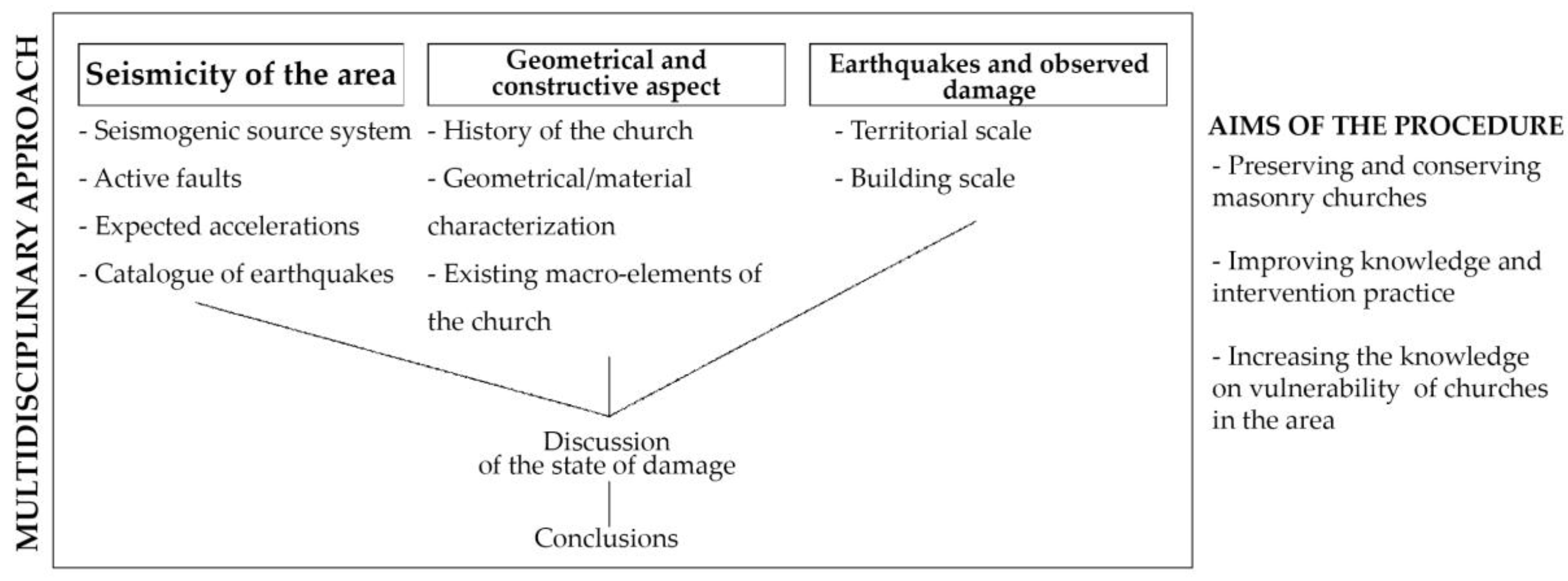
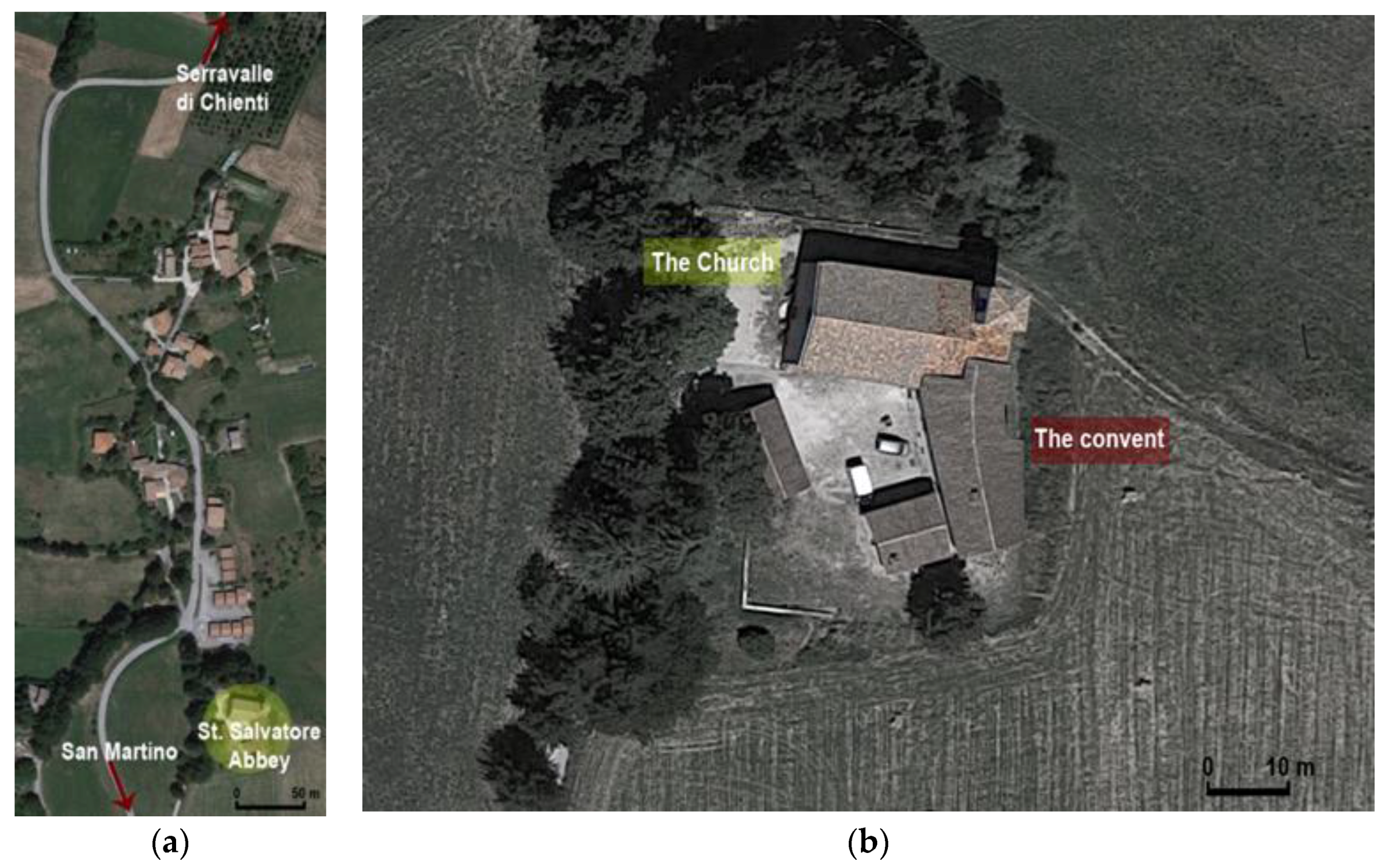

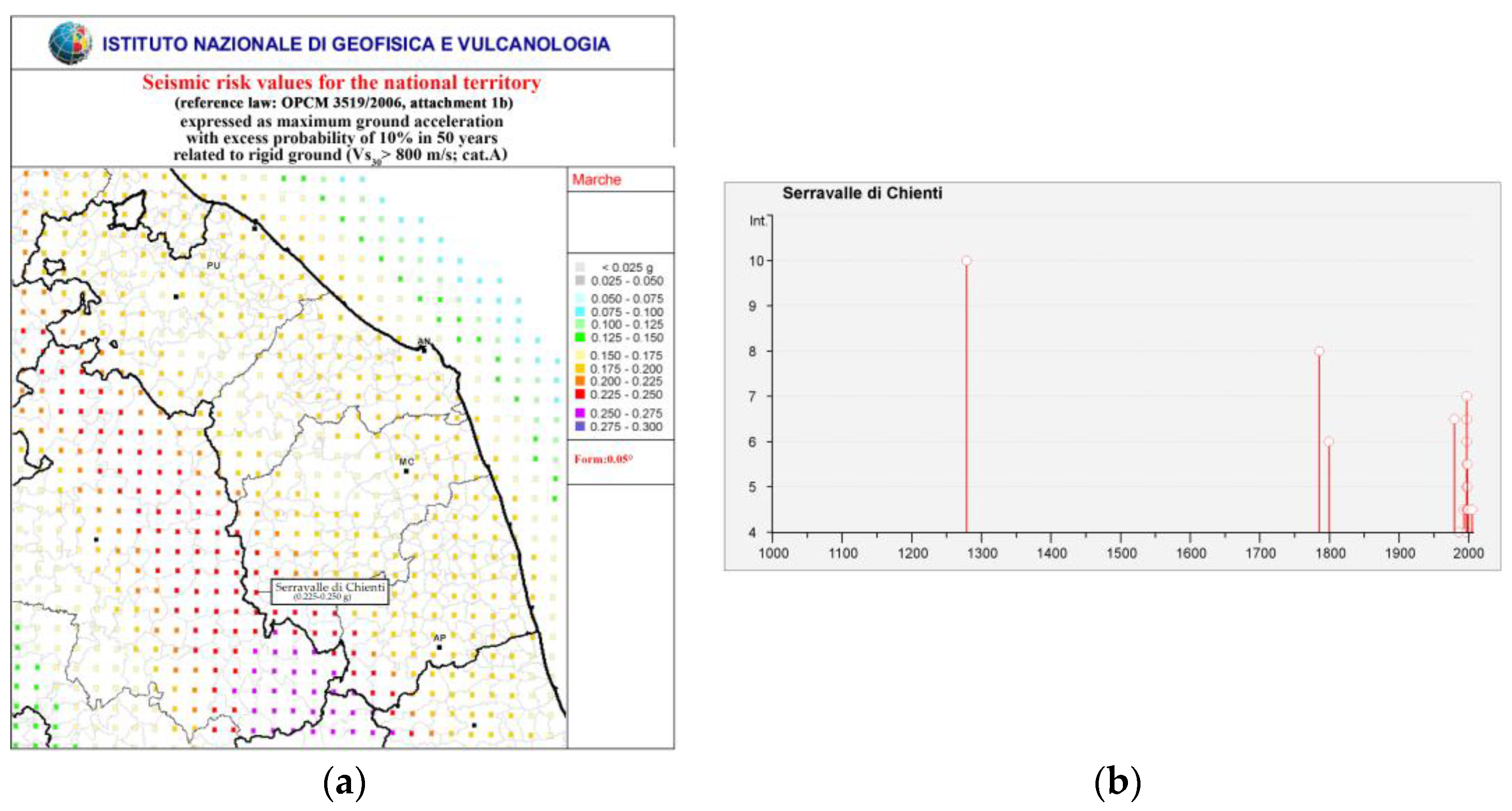

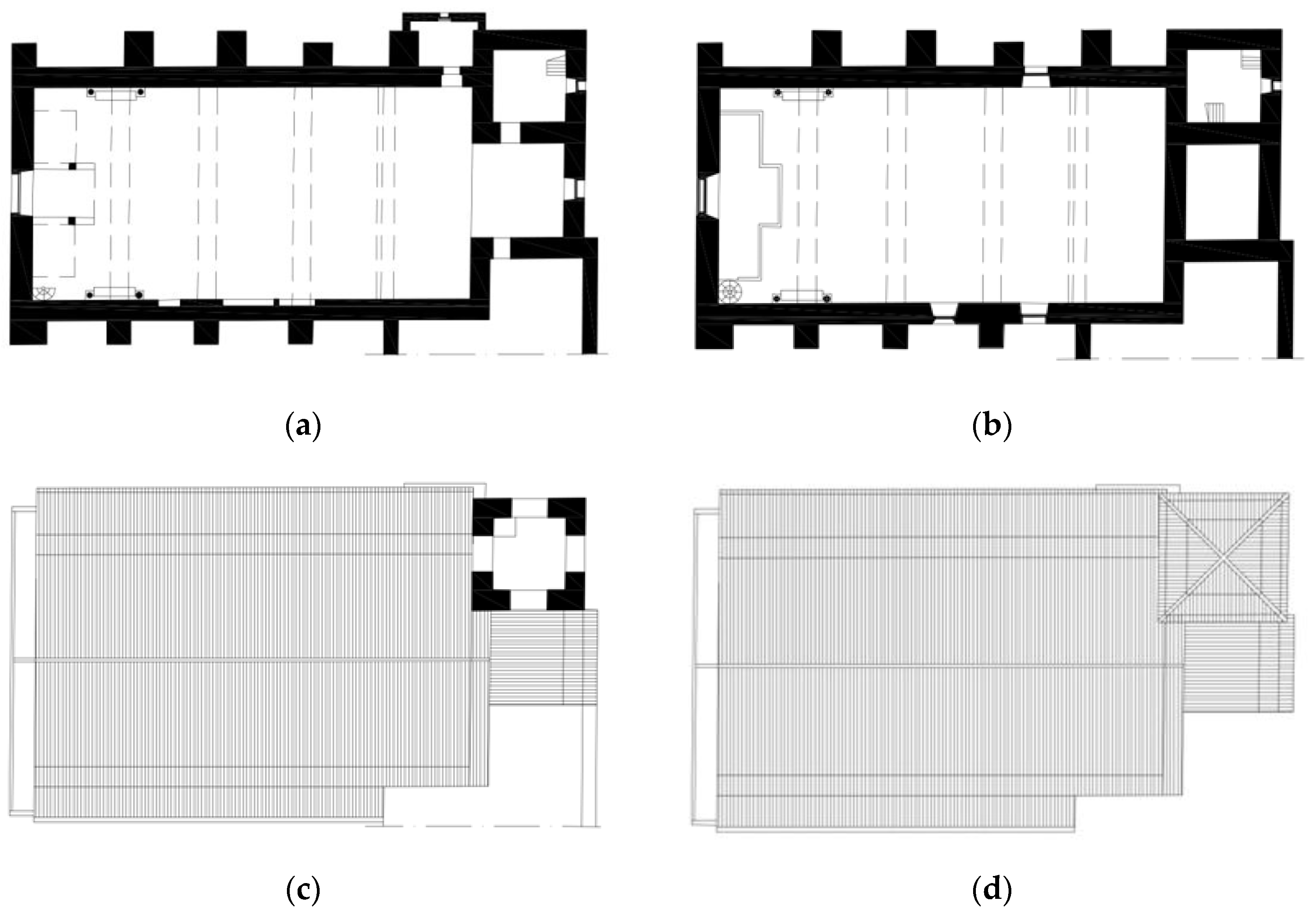


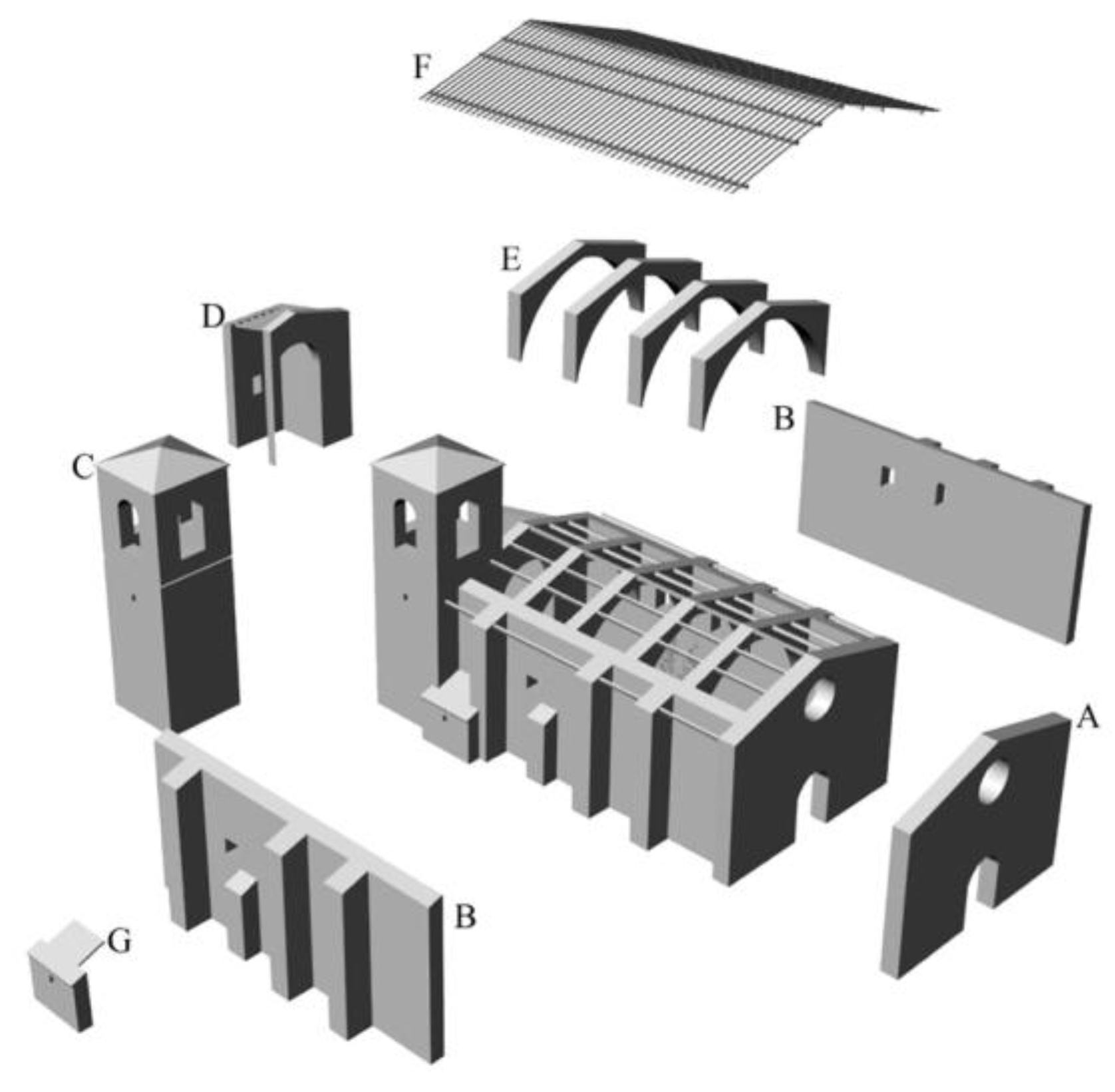
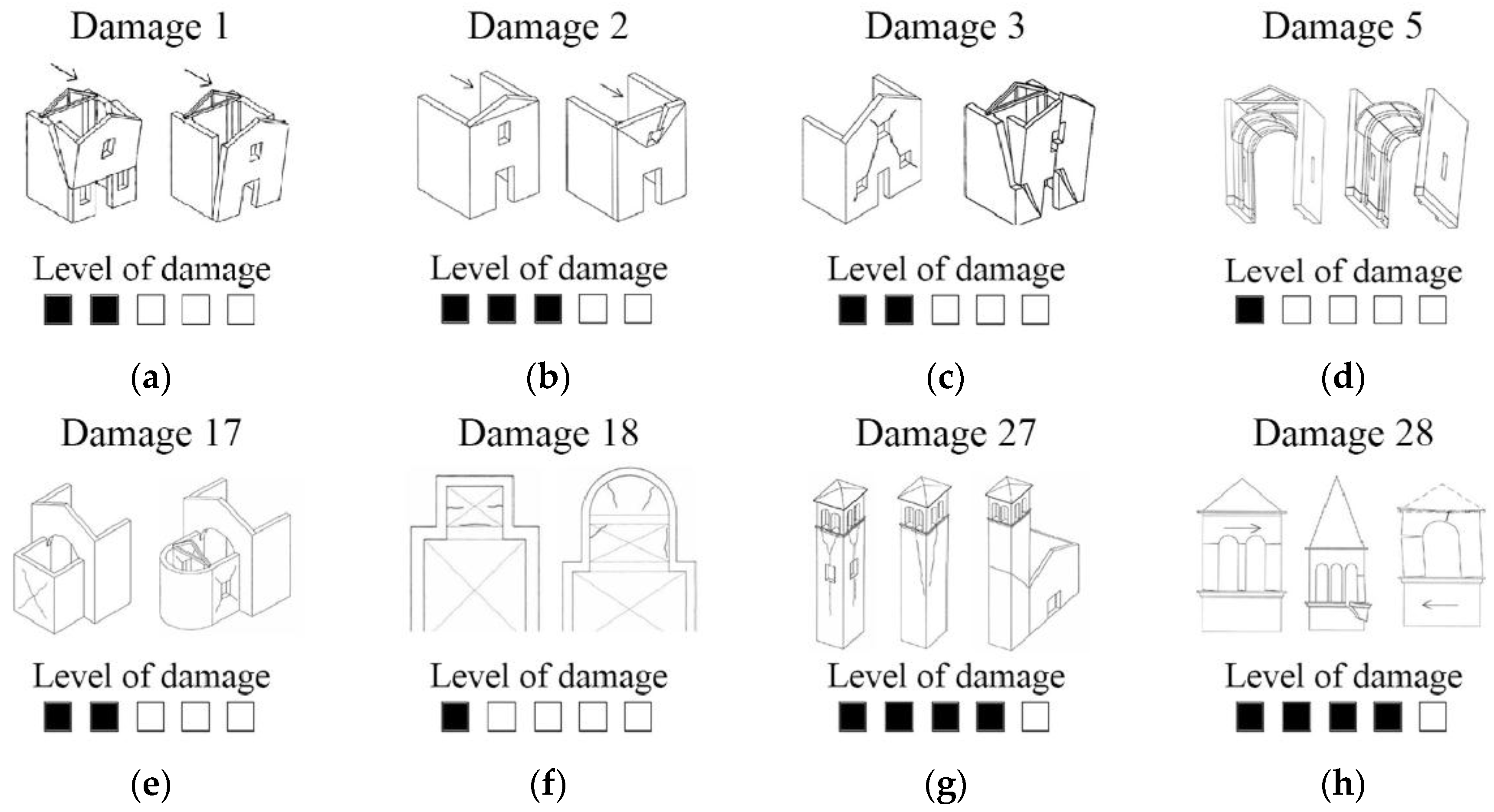


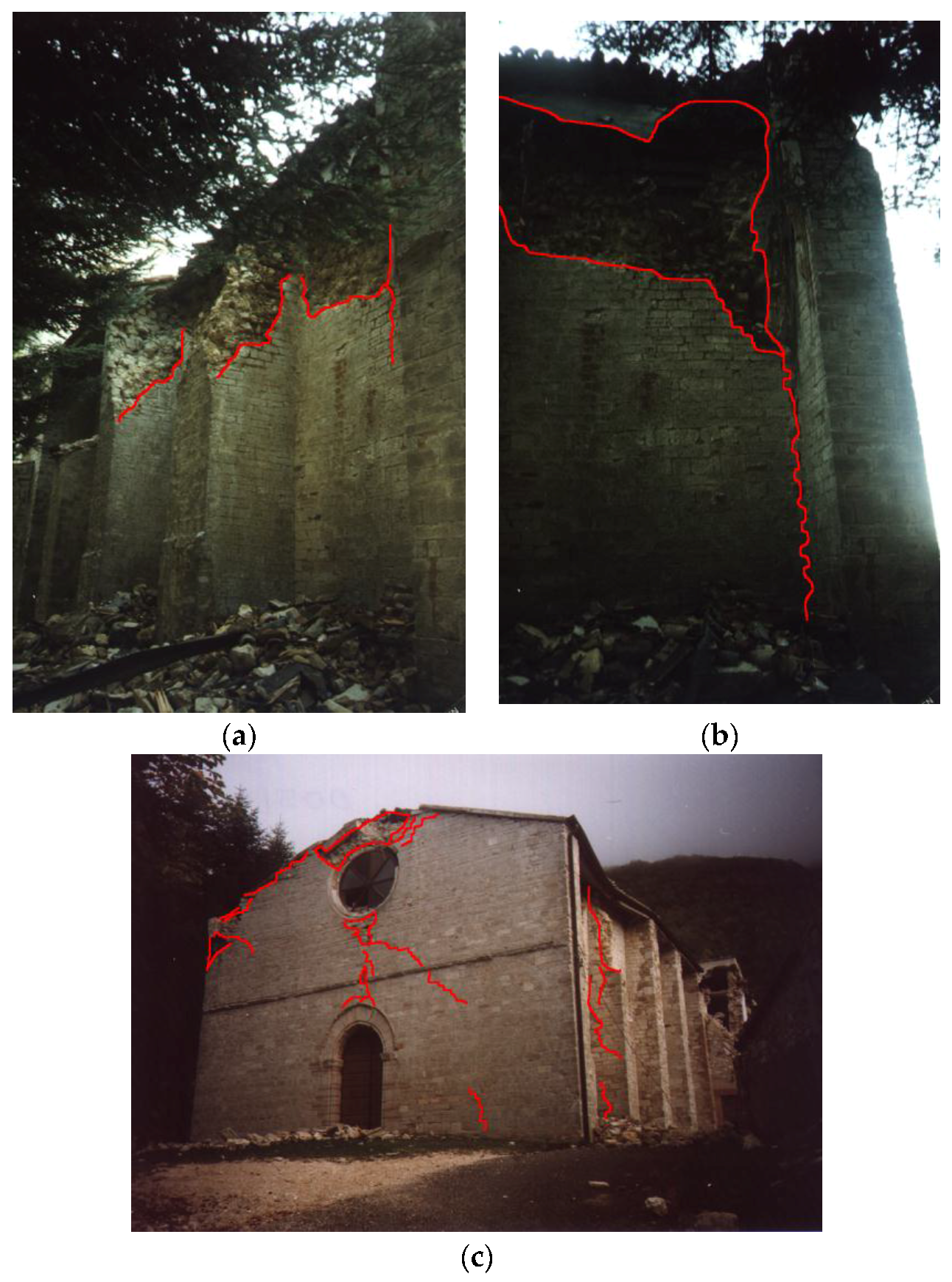
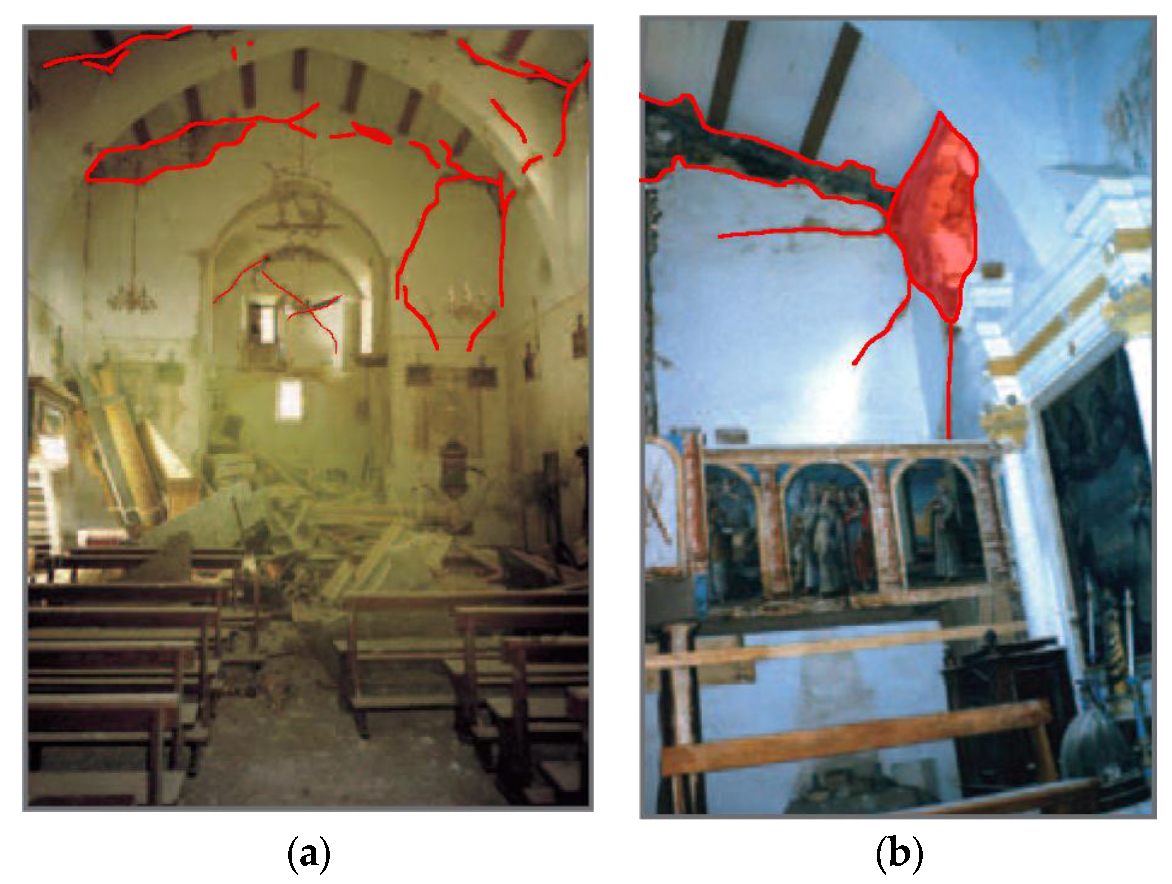

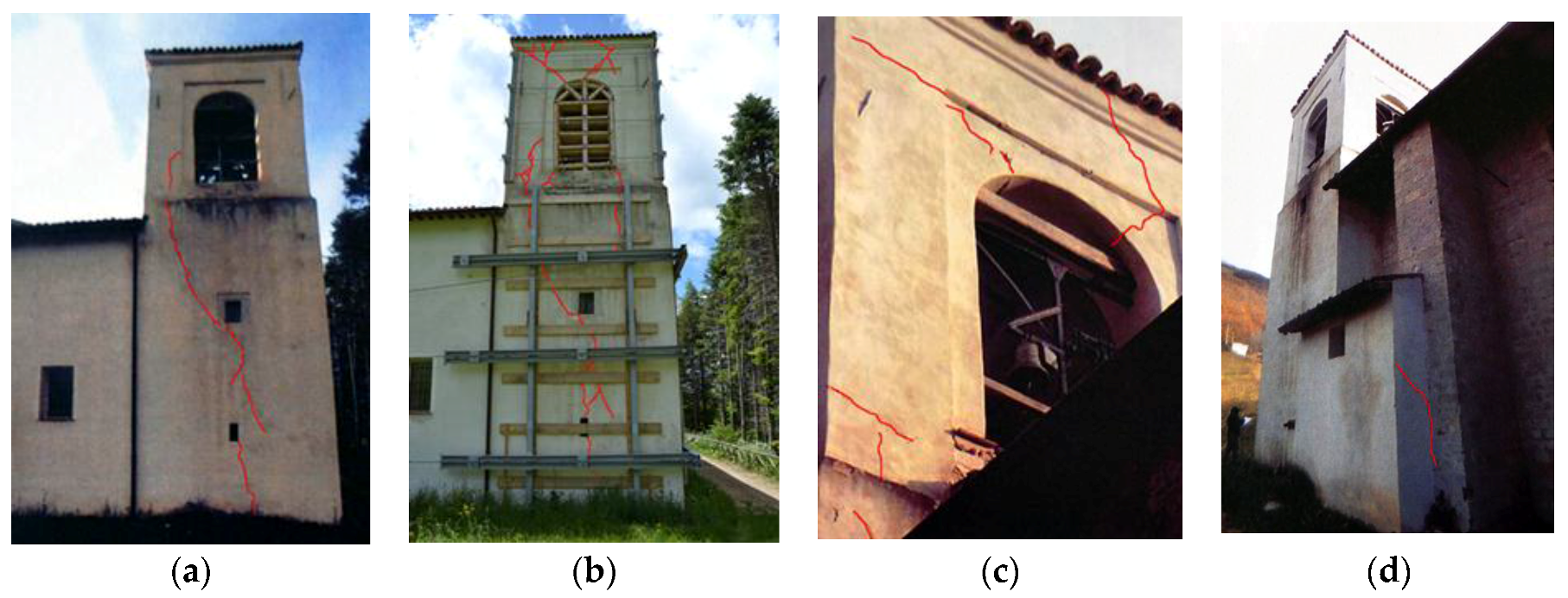
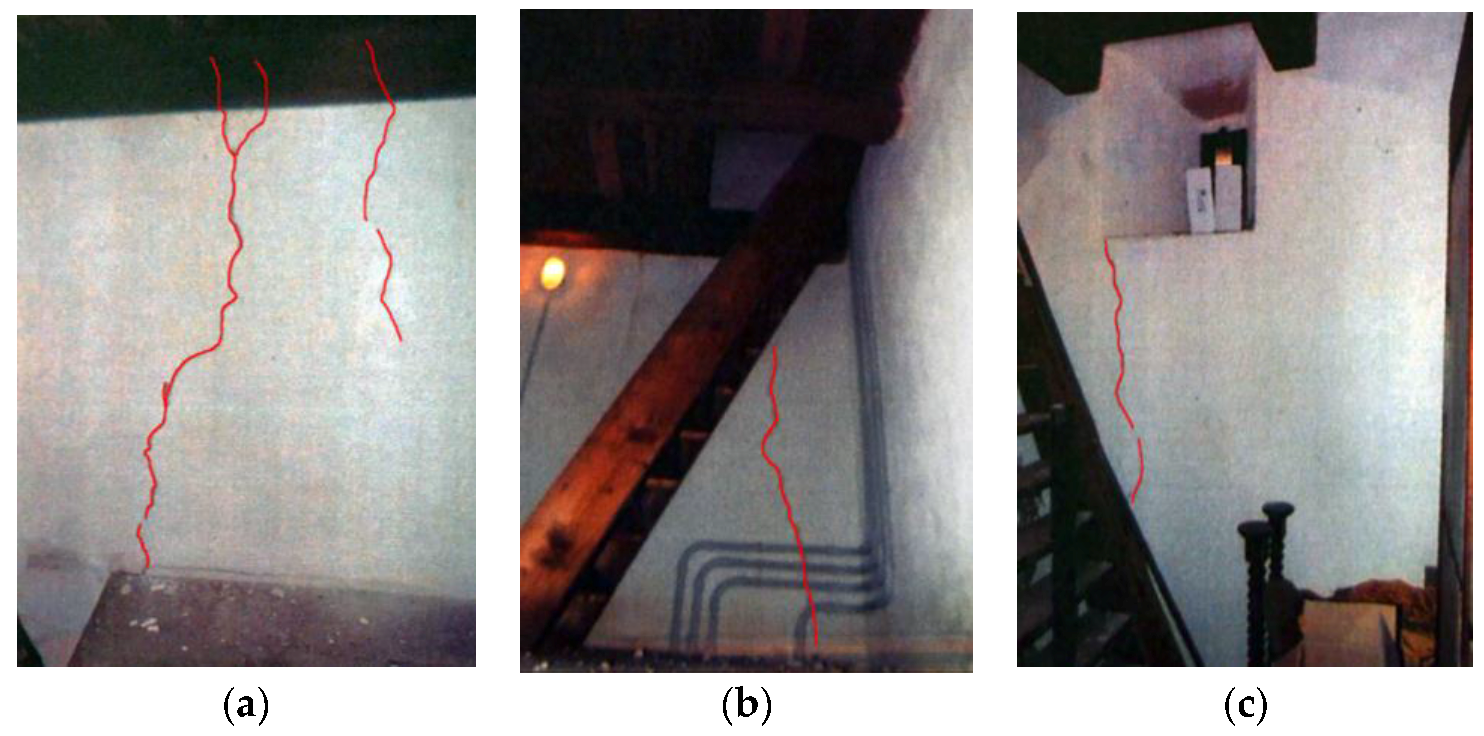
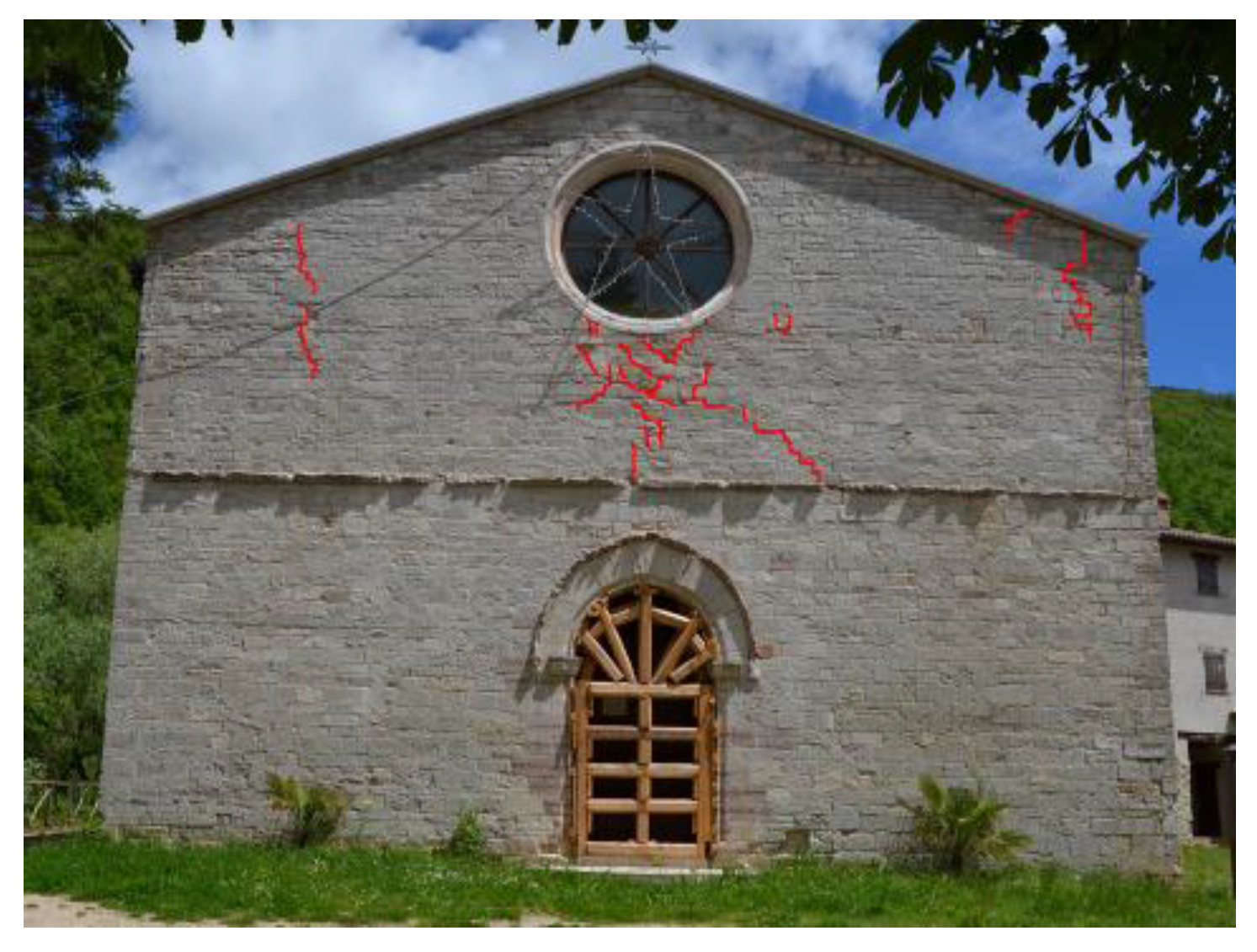
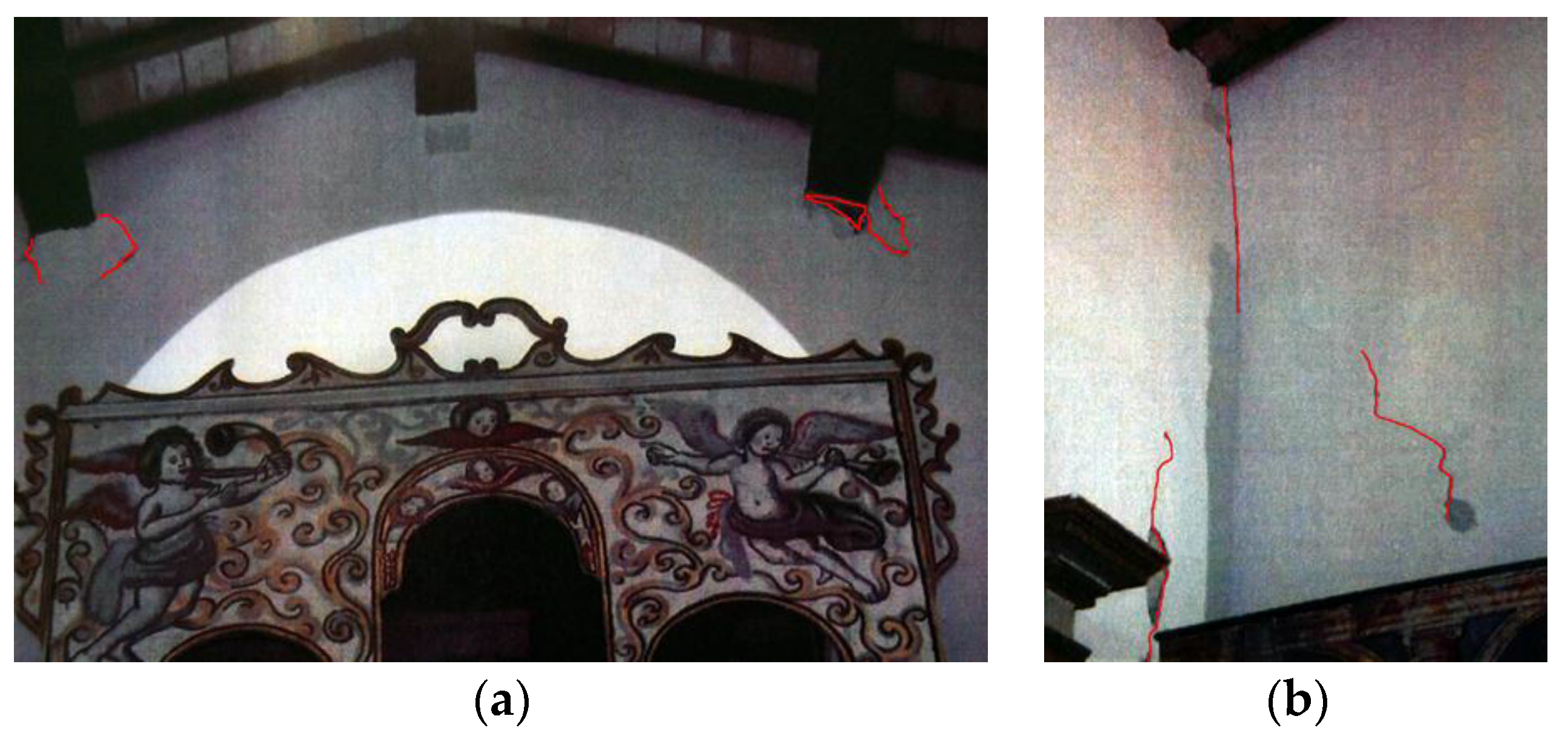
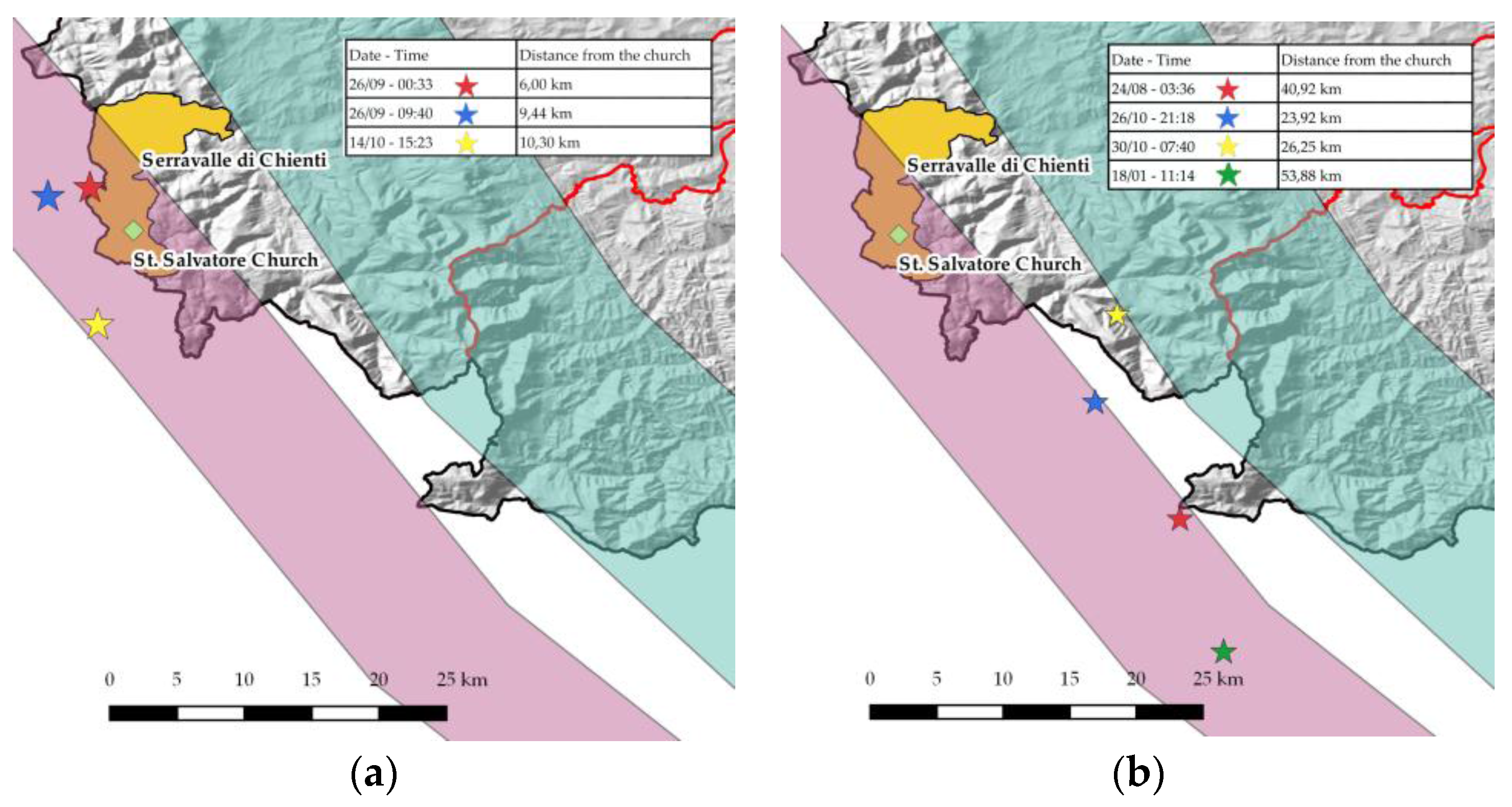
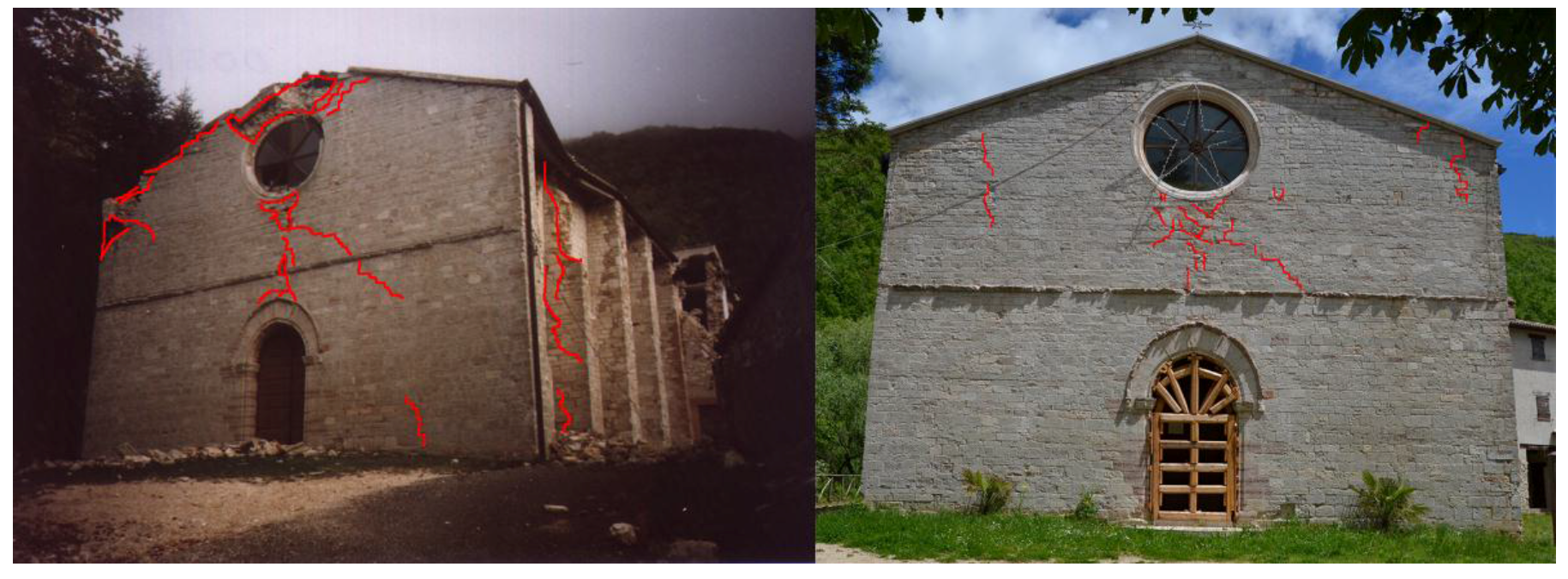
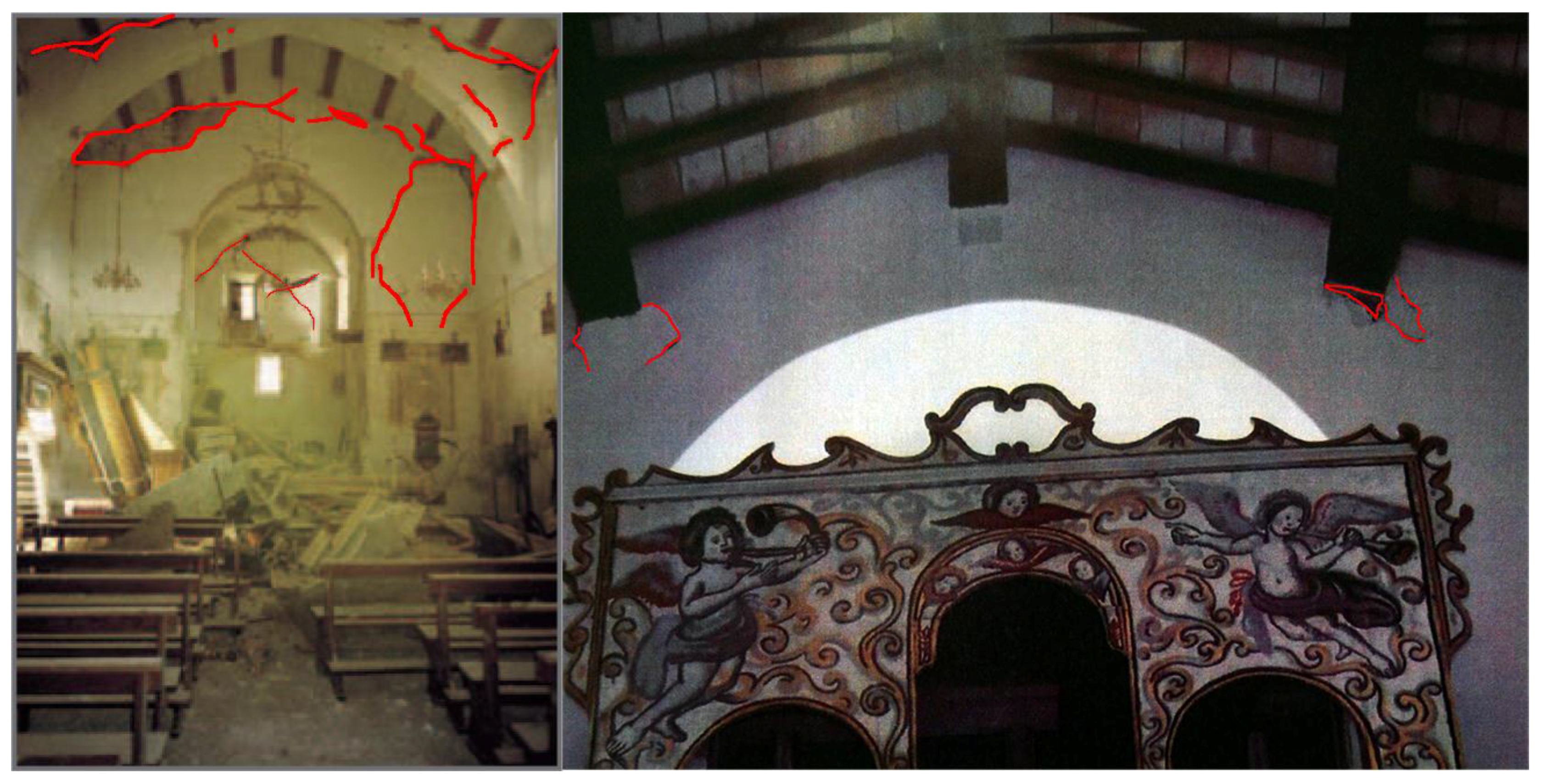
| Microseismic Intensity | Date Time | Localization | Epicenter Intensity | Moment Magnitude |
|---|---|---|---|---|
| 10 | 30 04 1279 18:00 | Camerino | 9 | 6.31 |
| 8 | 03 05 1785 02:30 | Alta valle del Chienti | 7 | 5.14 |
| 6 | 28 07 1799 22:05 | Appennino Marchigiano | 9 | 6.13 |
| NF | 10 09 1919 16:57:20 | Piancastagnaio | 7-8 | 5.32 |
| 6-7 | 19 09 1979 21:35:37 | Valnerina | 8-9 | 5.86 |
| 4 | 13 10 1986 05:10:01 | Appennino Umbro-Marchigiano | 5-6 | 4.65 |
| 3 | 03 07 1987 10:21:58 | Porto San Giorgio | 5.09 | |
| 4-5 | 04 06 1993 21:36:51 | Nocera Umbra | 5-6 | 4.50 |
| 4-5 | 05 06 1993 19:16:17 | Gualdo Tadino | 6 | 4.74 |
| 4 | 15 07 1997 08:51 | Appennino Umbro-Marchigiano | 4-5 | 3.69 |
| 5-6 | 03 09 1997 22:07:30 | Appennino Umbro-Marchigiano | 5-6 | 4.56 |
| 5 | 07 09 1997 23:28:06 | Appennino Umbro-Marchigiano | 5-6 | 4.38 |
| 4-5 | 09 09 1997 16:54 | Appennino Umbro-Marchigiano | 5-6 | 4.07 |
| 4-5 | 10 09 1997 06:46:51 | Appennino Umbro-Marchigiano | 5 | 4.16 |
| 7 | 26 09 1997 00:33:13 | Appennino Umbro-Marchigiano | 5.70 | |
| 6-7 | 03 10 1997 08:55:22 | Appennino Umbro-Marchigiano | 5.25 | |
| 6 | 06 10 1997 23:24:53 | Appennino Umbro-Marchigiano | 5.46 | |
| 7 | 14 10 1997 15:23:11 | Appennino Umbro-Marchigiano | 7-8 | 5.65 |
| 4-5 | 09 11 1997 19:07:33 | Appennino Umbro-Marchigiano | 5-6 | 4.90 |
| 5 | 07 02 1998 00:59:45 | Appennino Umbro-Marchigiano | 5-6 | 4.43 |
| 4-5 | 16 02 1998 13:45:45 | Appennino Umbro-Marchigiano | 5 | 4.03 |
| 5-6 | 21 03 1998 16:45:09 | Appennino Umbro-Marchigiano | 6 | 5.03 |
| 5 | 26 03 1998 16:26:17 | Appennino Umbro-Marchigiano | 6 | 5.29 |
| 5-6 | 05 04 1998 15:52:21 | Appennino Umbro-Marchigiano | 6 | 4.81 |
| 4-5 | 11 08 1998 05:22:59 | Appennino Umbro-Marchigiano | 5-6 | 4.53 |
| 4-5 | 29 11 1999 03:20:34 | Appennino Centrale | 5-6 | 4.38 |
| NF | 09 12 2004 02:44:25 | Zona Teramo | 5-6 | 4.18 |
| 2-3 | 12 04 2005 00:31:52 | Maceratese | 4-5 | 4.16 |
| 4-5 | 15 12 2005 13:28:39 | Valle del Topino | 5-6 | 4.66 |
| 3-4 | 10 04 2006 19:03:36 | Maceratese | 5 | 4.51 |
| MASONRY BLOCKS OF SQUARED STONE AND PEBBLES, TRIPLE FACADE | |||||||||||||
 |  |  | PHOTOS | ||||||||||
| Front | Corner | Inner masonry | |||||||||||
 |  |  | SCHEMES | ||||||||||
| Axonometry | Front | Section | |||||||||||
| Masonry made up of two facades built with squared blocks of stones. with the interposition of a pebble filling.Resistant elements with variable dimensions, but with defined edges. Wall texture which respects horizontal lines, partial offsets of vertical joints and presence of transversal stone joints. | DESCRIPTION | ||||||||||||
| Spruce travertine squares, also called sponge. | MATERIAL | ||||||||||||
 | Variable elements’ dimensions (external facade): s = 10 ÷ 20 cm h = 10 ÷ 25 cm l = 30 ÷ 70 cm |  | GEOMETRY | ||||||||||
| P.D. | MA. | F.EL. | S.G. | RE. EL. | O.R. | D.EL. | Category | Vertical | Out of plane | In plane | ANALISYS | ||
| R | R | R | PR | R | R | R | Schore method | A | A | A | |||
| Legend | P.D. MA. F. EL. S.G. RE. EL. O.R. D.EL. | Presence of bondstones Good quality of the mortar Shape of the elements Presence of staggering in the vertical joints Good quality of resistant elements Presence of horizontal rows Dimension of the elements | |||||||||||
© 2018 by the authors. Licensee MDPI, Basel, Switzerland. This article is an open access article distributed under the terms and conditions of the Creative Commons Attribution (CC BY) license (http://creativecommons.org/licenses/by/4.0/).
Share and Cite
Sferrazza Papa, G.; Silva, B. Assessment of Post-Earthquake Damage: St. Salvatore Church in Acquapagana, Central Italy. Buildings 2018, 8, 45. https://doi.org/10.3390/buildings8030045
Sferrazza Papa G, Silva B. Assessment of Post-Earthquake Damage: St. Salvatore Church in Acquapagana, Central Italy. Buildings. 2018; 8(3):45. https://doi.org/10.3390/buildings8030045
Chicago/Turabian StyleSferrazza Papa, Gessica, and Benedetta Silva. 2018. "Assessment of Post-Earthquake Damage: St. Salvatore Church in Acquapagana, Central Italy" Buildings 8, no. 3: 45. https://doi.org/10.3390/buildings8030045





